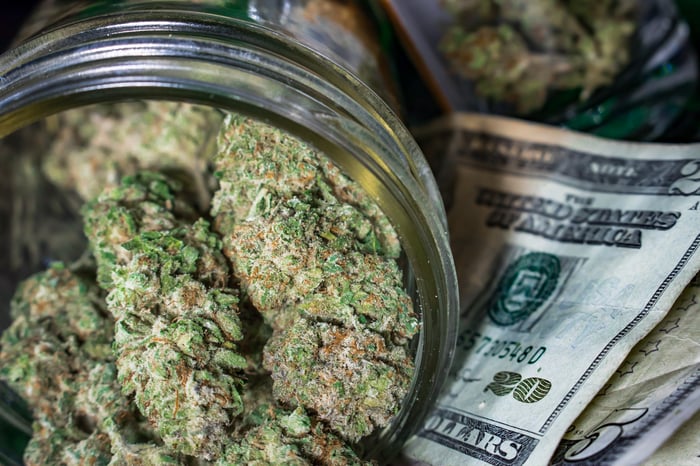There's little question that the legal cannabis industry could be a giant. Every year, tens of billions of dollars of marijuana is sold in the black market, so we know that consumer demand for the product is strong. Assuming cannabis legalization continues throughout North America, Wall Street's varied prognostications of $50 billion to $200 billion in worldwide weed sales by 2030 could very well prove accurate.
At the heart of this growth is the United States. Most investment banks are counting on the U.S. to account for a third to half of all global cannabis sales by the end of the next decade, making it a key source of marijuana investment.

Image source: Getty Images.
Marijuana's Schedule I classification is a major buzzkill
Yet despite this investment, cannabis firmly remains a Schedule I drug at the federal level. As a Schedule I substance, weed is entirely illegal, prone to abuse, and not recognized as having any medical benefits. Unfortunately, being illegal isn't the only worry for cannabis companies.
For one, even though the federal government has taken a hands-off approach to state-level management, U.S. multistate operators (MSOs) are still being forced to set up redundant operations because of marijuana's classification. In other words, because the interstate transfer/shipment of pot isn't allowed, vertically integrated MSOs are having to set up cultivation, processing, and retail stores in every state they're operating in, which isn't very efficient from a cost perspective.
Another problem is that selling a Schedule I or II substance exposes profitable businesses to Section 280E of the U.S. tax code. Originally implemented in 1982 to keep drug dealers from writing off "business expenses" on their federal income-tax returns, 280E disallows pot businesses from taking normal corporate income tax deductions, save for cost of goods sold. This means cannabis companies could have an effective federal income tax rate of over 70%!
And, as the icing on the cake, U.S. marijuana businesses have very limited access to basic banking services, which includes everything from loans and lines of credit to something as simple as a checking account. Banks and credit unions fear the potential financial and/or criminal repercussions of providing financial services to pot companies and have mostly chosen to stick to the sidelines. This leaves marijuana companies to primarily deal in cash, which is both a security concern and a growth constraint.

Image source: Getty Images.
Banking access for cannabis companies has quietly improved...
However, we've also (quietly) seen the number of depository institutions providing financial services to marijuana related businesses tick higher for five years. Between the third quarter of 2014 and the midpoint of 2018, the aggregate number of banks and credit unions providing basic banking services quadrupled from about 100 to 400, according to data from the Financial Crimes Enforcement Network (FinCEN). These figures then surged again, hitting a combined 723 depository institutions as of the end of the third quarter of 2019.
While the number of different depository institutions in the U.S. remains a highly fluid figure, the Federal Deposit Insurance Corporation, which you probably known best as the FDIC, lists 8,610 insured or supervised depository institutions as of Sept. 30, 2019. This means that only 8.4% of all depository institutions in the U.S. are currently dealing with the marijuana industry.
Interestingly enough, some of the biggest banks in the U.S. are those willing to take a stab at marijuana. In early 2017, journal American Banker released a study that examined medical marijuana businesses operating in Massachusetts between June 2015 and September 2016. The study found that 34% of these medical pot businesses had an account with the U.S.'s big-four: Bank of America (BAC 1.53%), Wells Fargo, JPMorgan Chase, or Citigroup. The study went on to find that Bank of America was the most accommodative of the big four (at least in Massachusetts), with more than half of all medical pot applicants having an account with BofA.

Image source: Getty Images.
... But it's beginning to level off
Yet the latest quarterly data update provided by FinCEN showed virtually no improvement in banking access from the previous quarter. Between the end of June 2019 and the end of September, the combined number of banks and credit unions dealing with marijuana businesses inched higher by just six, from 717 to 723. This broke a streak of strong banking access growth that began last year.
What gives, you ask? Part of the reason could have been financial institutions waiting to see the results of a vote on the Secure and Fair Enforcement (SAFE) Banking Act in Congress. The SAFE Banking Act wound up being passed 321-103 in the House in late September, a little later of a vote than banking analysts had been expecting.
Although the SAFE Banking Act would free up banks and credit unions in legalized states to provide financial services to the marijuana industry without the fear of financial or criminal penalty, the Act itself has no chance of passing at the moment. Senate Majority Leader Mitch McConnell (R-Ky.) has made it abundantly clear that any and all cannabis reform measures won't reach the Senate floor for vote. This makes it unlikely that the green carpet will be rolled out for banks to provide basic financial services to the U.S. weed industry anytime soon.
Another possible reason for the slowdown in the third quarter "may be explained by filers exceeding the 90-day follow-on Suspicious Activity Report (SAR) filing requirement," according to the FinCEN update. Banks are required to file SARs as part of banking guidance issued during the Obama administration, but "several filers take 180 days or more to file a continuing activity report." That's an issue given that "after 90 days, a depository institution is no longer counted as providing banking services until a new guidance-related SAR is received." So, chalk up regulatory paperwork as a potential reason for the flattening of bank involvement in the pot industry.

Image source: Getty Images.
A lack of access to financing is a big problem for U.S. pot stocks
However, it's important to realize that it isn't the banks that are the real losers here. That title goes to U.S. cannabis stocks that have very limited access to basic financial services. Many of these marijuana companies have had to turn to unique measures to ensure their survival or bolster their balance sheets.
For example, MSO Cresco Labs (CRLBF -4.11%) is faced with expanding into a number of core markets, including Illinois, which is set to commence recreational weed sales on Jan. 1, 2020. At the same time, Cresco is also in the process of buying Origin House in what is currently a pending acquisition. With access to cash scarce, Cresco recently turned to sale-leaseback agreements with Innovative Industrial Properties to improve its cash position.
A sale-leaseback agreement is where a cannabis company like Cresco sells one of more of its properties to a cannabis-focused real estate investment trust (REIT) in exchange for cash. In return, the acquiring REIT then leases the property back to the cannabis company in question for an extended period of time. In Cresco's case, it sold two properties worth $32.8 million.
Without easy access to basic financial services, it wouldn't be surprising to see an uptick in sale-leaseback agreements, amended or scrapped acquisitions, or convertible debt issuances among U.S. pot stocks in the near future.





